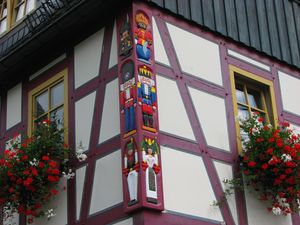Students:Tuesday, Day Four
Today was the German Day. We caught a rental bus from the town square and were transported over the border to the toy producing town of Seiffen. Dropping into the house of the local pastor, Michael Harzer, the students heard a presentation from Herr Harzer on the history of the local region and town, which included a discussion afterwards with local resident, Herr Peetz, an 83-year-old who has lived in Deutschneudorf his whole life and as a boy used to accompany his post master father on mail runs into Sudetenland on the Czech side of the border. Herr Peetz explained that no distinction was made by the Germans themselves before the war between those living on the German side of the border and those living on the Czech side. After the expulsion of the Sudeten Germans from Czechoslovakia after the war, many came over to the German side of the Ore Mountains in the hope that the expulsion was temporary only and they could quickly return. However, when it became apparent that the expulsion order would not be overturned, there was not enough accommodation on the German side and most Sudetens therefore emigrated to Dresden or further into the German interior. Only very few remained in the Ore Mountains.
Dr Jens Uhlig also delivered a presentation on regional planning from a Saxon perspective. Dr Uhlig talked about the practice of both German and Czech regional planning authorities exchanging planning documentation for comment by each side, the involvement by each side in gaining UNESCO cultural heritage status for the former Ore Mountain silver and tin mining areas, the exchange of students studying traditional farming methods on the German side of the border sponsored by Zil Drei, the regeneration of pastureland important for flood protection via the Clara@eu project, and cooperatioan on creating a 3km wind turbine-free zone either side of the border.
Lunch was eaten at a local restaurant called Pyramid, which represented the famous local Christmas decoration called a Christmas pyramid with rotor blades on top that are driven by the hot air emitted of candles placed on the base.
Herr Harzer then returned to guide the student group around the most interesting sights of the town, including the huge holes created in the 16th century as a result of tin mining. An ampitheatre created by this activity was the venue for an impromtu singing performance by Herr Harzer and his young children. The tour ended with a visit to a local wooden toy manufacturing factory that specialised in miniature toys, and in particular miniature carriages, and which included a talk from the factory owner on the history of his manufacturing business.
Finally, the students got an opportunity to wander the town by themselves and make some purchases before catching the bus back to HSK at 4.30. The day ended with presentations of the results of the previous day's stakeholder mapping, and a compilation of key comparative points on both sides of the border on the summer school wiki.
More images: Day Four Photos
